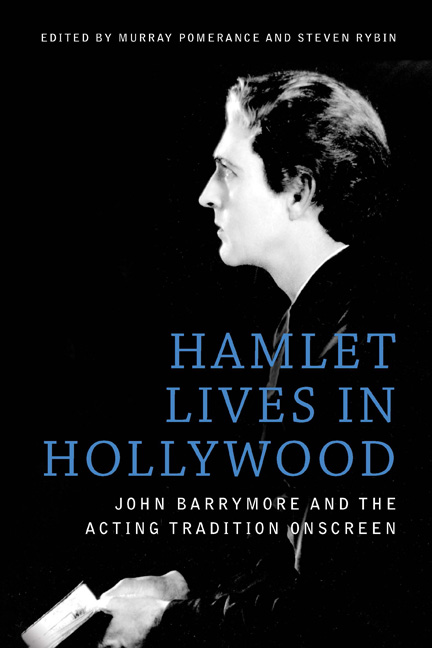Book contents
- Frontmatter
- Contents
- List of Figures
- The Contributors
- Acknowledgments
- Introduction
- 1 The Pre-Bard Stage Career of John Barrymore
- 2 Dangerously Modern: Shakespeare, Voice, and the “New Psychology” in John Barrymore's “Unstable” Characters
- 3 The Curious Case of Sherlock Holmes
- 4 John Barrymore's Introspective Performance in Beau Brummel
- 5 “Keep Back your Pity”: The Wounded Barrymore of The Sea Beast and Moby Dick
- 6 From Rome to Berlin: Barrymore as Romantic Lover
- 7 The Power of Stillness: John Barrymore's Performance in Svengali
- 8 Prospero Unbound: John Barrymore's Theatrical Transformations of Cinema Reality
- 9 A Star is Dead: Barrymore's Anti-Christian Metaperformance
- 10 Handling Time: The Passing of Tradition in A Bill of Divorcement
- 11 John Barrymore's Sparkling Topaze
- 12 “Planes, Motors, Schedules”: Night Flight and the Modernity of John Barrymore
- 13 Barrymore and the Scene of Acting: Gesture, Speech, and the Repression of Cinematic Performance
- 14 “I Never Thought I Should Sink So Low as to Become an Actor”: John Barrymore in Twentieth Century
- 15 Barrymore Does Barrymore: The Performing Self Triumphant in The Great Profile
- Works Cited
- Index
3 - The Curious Case of Sherlock Holmes
Published online by Cambridge University Press: 23 June 2018
- Frontmatter
- Contents
- List of Figures
- The Contributors
- Acknowledgments
- Introduction
- 1 The Pre-Bard Stage Career of John Barrymore
- 2 Dangerously Modern: Shakespeare, Voice, and the “New Psychology” in John Barrymore's “Unstable” Characters
- 3 The Curious Case of Sherlock Holmes
- 4 John Barrymore's Introspective Performance in Beau Brummel
- 5 “Keep Back your Pity”: The Wounded Barrymore of The Sea Beast and Moby Dick
- 6 From Rome to Berlin: Barrymore as Romantic Lover
- 7 The Power of Stillness: John Barrymore's Performance in Svengali
- 8 Prospero Unbound: John Barrymore's Theatrical Transformations of Cinema Reality
- 9 A Star is Dead: Barrymore's Anti-Christian Metaperformance
- 10 Handling Time: The Passing of Tradition in A Bill of Divorcement
- 11 John Barrymore's Sparkling Topaze
- 12 “Planes, Motors, Schedules”: Night Flight and the Modernity of John Barrymore
- 13 Barrymore and the Scene of Acting: Gesture, Speech, and the Repression of Cinematic Performance
- 14 “I Never Thought I Should Sink So Low as to Become an Actor”: John Barrymore in Twentieth Century
- 15 Barrymore Does Barrymore: The Performing Self Triumphant in The Great Profile
- Works Cited
- Index
Summary
He was, I take it, the most perfect reasoning and observing machine that the world has seen.
Arthur Conan Doyle, A Scandal in BohemiaIf, in this line from Conan Doyle's 1891 short story, Watson's description of Sherlock Holmes resembles a camera, it is because both the fictional detective and that other “observing machine” share an affinity as emblems of a distinctly modern way of seeing. Holmes is “perfect” because nothing escapes his gaze. His eyes constantly detect and collect visual evidence that others do not and in ways that others cannot. His visual acuity is matched by the speed of his reasoning which allows him to decipher a person at a glance and, in turn, masterfully to navigate a world of deceptive appearances.
The photographic apparatus is not a “reasoning machine” but, in the latter half of the nineteenth century, its powers of detection were preeminent. At the time that Conan Doyle was writing, the mechanical “eyes” of cameras employed for still and motion photography were radically transforming visuality and the experience of modern life. With innovations in chronophotography and early cinematic uses of techniques such as time lapse and slow motion, the camera developed an identity as a detective that could reveal secret realities in the hitherto undisclosed zone beneath the appearances of things, that which Walter Benjamin called the domain of the “optical unconscious” (510–12). The avant-garde filmmaker and theorist Germaine Dulac described the cinema along these lines as “an eye wide open on life, an eye more powerful than our own and which sees things we cannot see” (39).
In the early twentieth century the resemblance between Holmes and the camera evolved considerably into a cinematic phenomenon. Throughout the silent era Conan Doyle's detective stories were adapted into short and feature-length films by a wide range of studios, including Biograph, Vitagraph, Universal, Essanay, Goldwyn Pictures, Éclair, and several smaller companies in Britain and Germany. The international popularity and pervasiveness of Holmes are quite remarkable. Between 1908 and 1911, Nordisk Film in Denmark produced a series of at least twelve short films featuring Holmes; Éclair in France produced eight in 1912 alone; and, from 1921 to 1923, Stoll Pictures in England produced a total of forty-five shorts and two feature-length films. The vogue, which included Buster Keaton's celebrated Sherlock, Jr.
- Type
- Chapter
- Information
- Hamlet Lives in HollywoodJohn Barrymore and the Acting Tradition Onscreen, pp. 35 - 46Publisher: Edinburgh University PressPrint publication year: 2017



